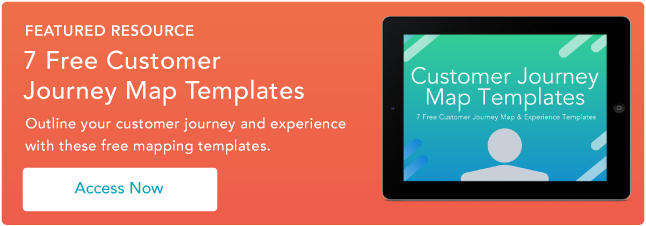What is a 360-degree customer view?
When you have a 360-degree view of an area, you can see everything around you from all angles.
Along the same lines, a 360-degree customer view refers to a complete view of your customer — that includes their every interaction with your brand, from the contact form they submitted to their most recent customer service call.
By retrieving data about your customer during the buyer’s journey, you’ll better understand them and how they feel throughout every step.
This is crucial to your business' success because when you understand how your customer feels, you’re able to show them empathy. Empathy allows you to connect with your customer on a more personal level, rather than transactional. This fosters trust and promotes loyalty and retention — all factors that directly impact your bottom line.
Though compiling customer information requires intensive collaboration and organization across your teams (a CRM — like HubSpot — can simplify this), reaping its valuable benefits make the effort worthwhile.
On that note, let's hone in on some of those specific benefits next.
Benefits of a 360-Degree Customer View
Personalized Customer Experience
Now more than ever, consumers prefer personalized shopping experiences. According to Accenture, 91% of consumers are more likely to shop with brands that offer relevant recommendations catered to them.
Aggregating all customer data in a 360-degree view gives you complete knowledge of the customer, so you can easily refer to their previous activities and engagements with your company. For instance, this context can help your service team tailor each interaction to a specific customer and find the best solution for their needs efficiently.
Additionally, personalizing customer experience will likely prolong customer loyalty by fostering a trustworthy relationship.
Speedy Service Response
Customer intelligence is also crucial to help your service reps succeed. Once provided with a customer’s full story, your team members can work quickly to solve the customer’s issues.
For example, I’m often frustrated as a customer when companies transfer me back and forth between agents — this is a time-consuming process and I often find myself repeating my case to each rep.
These unproductive interactions negatively impact three things: the customer’s time, the customer’s patience, and the company’s resources. This could all be prevented by aggregating all the client data in one place, like Service Hub.
By having access to each customer’s interactions and inquiries, it makes life easier for both the customer and service representatives. Reps can get to the bottom of a problem more efficiently and effectively, which boosts customer satisfaction.
In fact, a quick response from the service team is necessary for business success. HubSpot Research found that 90% of customers rate an "immediate" response as important or very important when they have a customer service question. And for reference, 60% of customers define "immediate" as 10 minutes or less.
Enhanced Predictive Analysis
Gathering comprehensive customer information can also help strengthen your company’s predictive analytics. Predictive analytics draw insights about your customer based on their past and present behavior to predict their future needs and wants.
This will help you stay one step ahead so you can prepare as needed to meet these expectations — you may even offer relevant services through upselling or cross-selling. Predictive analytics can also shine light on how various parts of the buyer’s journey may hinder or attract the customer, and what steps you can take to enhance their experience.
On a larger level, these predictions can improve company strategy. For example, valuable insights from customer data can be applied to better future campaigns and product updates to solve a customer’s pain point.
Compile as much information as you can for each 360-degree view for the most reliable forecasts. The more details you can get your hands on, the better.
Now, let’s look at how you can create a 360-degree view of your customer.
How to Get a 360-Degree View of Your Customer
1. Use a customer relationship management (CRM) software.
A CRM is where you can store all of your customer data, making it a perfect place to track all the touch points a customer has with your company.
In each customer profile, record details such as previous purchases, inquiries, and any other communication. These 360-degree views in your CRM should be updated after each new interaction.
It’s also a good idea to grant CRM access to all customer-facing departments (e.g. Sales, Marketing, Service, Support) to ensure everyone’s on the same page when communicating with a customer. This way there’s little to no room for error or confusion while working with a specific customer.
2. Practice social listening.
Customer interactions also include their behavior on social media. Social listening is the practice of monitoring any discussions of your brand, or related topics, on social media channels.
Social listening is valuable because people tend to share unfiltered thoughts and opinions on social media, which can prove to be valuable feedback for your company. You can also refer to their thoughts and reviews while creating or updating your buyer personas to improve accuracy and focus your marketing and sales efforts.
Check out this list for some social listening tools to get you started.
3. Conduct a data audit.
Alright, so you’re ready to create customer profiles starting with the next customer interaction — except, what about all of your pre-existing data?
Whatever you do, don’t wipe your historical data. Instead, take time to organize that information and assign it to the appropriate customer (HubSpot’s CRM makes this data import simple). It’s also common for various departments to catch unique information about a customer, so be sure to gather details from all departments and add them to your 360-degree views as well.
If you’re not using a CRM to automatically organize your customer-related information, you’ll still want to create a system for entering and editing those details. This will ensure easy and streamlined access to that information in the future.
Building a 360-degree customer view can help you break down how specific customers react and feel as they engage with your company, throughout every point in the buyer’s journey. The process of making these customer profiles is ongoing, but with each new detail, you unlock useful information to help you delight your customers.
Customer Segmentation



![Customer Profiling in 10 Easy Steps [+ Templates]](https://53.fs1.hubspotusercontent-na1.net/hubfs/53/customer-profiling_2.webp)

![How to Get B2B Customer Segmentation Right [+Tips]](https://53.fs1.hubspotusercontent-na1.net/hubfs/53/b2b-customer-segmentation-1-20250109-7176487.webp)





![8 Companies Mastering Customer Segmentation [+ Examples]](https://53.fs1.hubspotusercontent-na1.net/hubfs/53/customer-segmentation-examples_6.webp)
